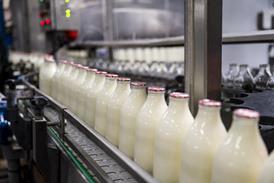In an ‘unusual situation’, the mochi maker has u-turned on plans to switch all its production to a new factory in Kettering, leaving staff angry
When Little Moons first started plotting its ‘New Moon’ factory in Kettering, it was meant to mark a defining moment for one of the food industry’s rising stars, as it sought to catapult itself to even greater heights.
But just months after the site opened, Little Moons is already planning its closure, capping a tough year for a burgeoning company in clear financial turbulence.
Before last week, even Little Moons staff were readying themselves for the New Moon to be the company’s sole factory, with the shutters set to close on its two London factories next June. But last Thursday, a sudden u-turn was announced that will instead see everything consolidated back to the London plants.
The move has angered workers at the Kettering factory, who now face the prospect of imminent unemployment, and fears abound that many could be ineligible for a redundancy payout. “I’ll just say we were promised the best and didn’t receive that,” says one.
So what’s gone wrong?
Little Moons made the decision to build the Kettering factory in late 2021 when annualised sales of its mochi ball ice creams had recently doubled to £43m after being discovered on TikTok. And with founders Vivien and Howard Wong preparing for a private equity dog fight for a multimillion-pound stake in their business, they believed future growth could not be met through the existing factories alone.
Insiders also told The Grocer that with potential investors circling, plans for a new factory were thought to give added weight to the company’s alluring sales forecasts at the time.
Rises and falls
2010: Little Moons is founded by siblings Vivien and Howard Wong
February 2021: Mochi balls go viral on TikTok, leading Little Moons’ sales at Tesco to rise eight-fold in one week
Late 2021: Little Moons decides to open a new factory in Kettering
March 2022: Private equity firm L Catterton buys a large minority stake in the business
March 2024: It emerges Little Moons is looking to close its two London factories and consolidate everything into the Kettering site
November 2024: Staff are told the Kettering site will now close and the London sites remain open
But according to sources close to the business, two unfortunate events then coincided.
The first was that sales began to stutter. A business selling six small ice cream balls for £5 was always going to be vulnerable in an economic downturn amid soaring costs, and the past 12 months have seen sales in the UK – Little Moons’ biggest market – fall by 3%, according to NIQ. While hardly a nosedive, it is a sharp plateau for a company used to double-digit annual growth.
The second was that Little Moons realised its initial premise was flawed: in fact, through reconfiguration there was enough capacity to meet demand in its London factories. The Park Royal site had only opened in 2020 just before Covid lockdowns and the company’s TikTok-inspired sales boom, meaning amid the chaos, it had little time to optimise the factory’s efficiency.

With the passage of time, however, insiders say they realised the factory could produce at least 50% more than initially thought. This left Little Moons paying for more production capacity than it ever required, while simultaneously making less use of it than it once foresaw.
Costs to build the new factory also started to soar. Initial estimates predicted the 50,000 sq ft facility would cost around £25m, but current employees say the figure is now closer to £40m for the site’s full set-up and initial running costs. This has led the Wongs, alongside private equity partner L Catterton, to pump at least £10m extra cash into the business, according to City sources.
Joanna Allen review
In June, Little Moons hired ex-Graze CEO Joanna Allen to try to improve the situation. Allen launched a review which produced eight potential courses of action and found closing the Kettering site was the least worst option in terms of cashflow.
According to Little Moon’s presentation this week, while the New Moon’s rent is half the price of its main London site, its mochi making is slower and therefore 40% more expensive. Its fixed costs are also significantly more. “This factory was going to be highly automated,” said ops director David Proctor, according to the meeting’s minutes. “This was dialled back.”
While in better circumstances it could have waited, “Little Moons didn’t have the incoming money (from sales growth, NPD or investment) to pay for the time needed to get to the required efficiency,” say internal notes given to staff on Thursday.

When the leadership made the final call on closing the factory is unclear. Up until last week, new staff in Kettering were still arriving. Builders and contractors remained on site. At its London factories, employees were still expecting imminent redundancy after Little Moons had reaffirmed they were closing these sites despite pushing the date back to June.
Last week’s announcement was therefore a shock to almost everyone. At 1pm on Thursday, employees at the Kettering site say they were called into a meeting, told the news, and asked to clear out their lockers and leave immediately via a fire escape.
A speech from Vivien Wong a few days later did little to calm the mood.
Now a week on, a skeleton crew of about 20 people remains each day tasked with clearing out stock and cleaning the factory, although all the ‘movers and makers’ – the term for production operatives – will be paid until 31 December. Little Moons told them the factory’s immediate closure was necessary for food safety reasons.
Little Moons recognises mistakes were made. When asked by staff on Thursday whether the company would “admit to a lack of leadership’ and bad decision making at the top level”, its CFO Nick Smith was among those to say “there has been poor decision making,” according to internal records.
Redundancy worries
Many employees’ biggest concern now is their redundancy package. Many are full-time and only joined within the last year, meaning only four of the factory’s 192 staff are eligible for statutory redundancy pay. Management have promised, however, that all staff will be offered redundancy regardless of time served.
In the staff meeting on Tuesday, the HR team acknowledged this was a “very unusual situation where we have opened a new factory and we are now proposing to close with people with very little service”.
“In most situations people have seen a decline and also have a length of service so are more comfortable to go through this process. This situation is very different,” said HR director Paul Clipson, according to the meeting’s minutes.
There is also no reason to doubt this is the best option for Little Moons. It’s just a very costly one. Andy Searle, MD of AlixPartners, says in a situation like this, a company can expect to recover only a share of the capital spent and this can often take months or even years to come through. The fact Little Moons has decided this is its best course of action gives an indication of the situation it’s in.
But the real losers here are the employees, many of whom left previous jobs in the hope of a promising career move at Little Moons’ new state-of-the-art factory. That dream has rapidly evaporated.
So while those in the boardroom had tough decisions to make while nursing cash flow and valuation losses, they are garnering little sympathy on the factory floor.
Little Moons declined to comment.




















1 Readers' comment